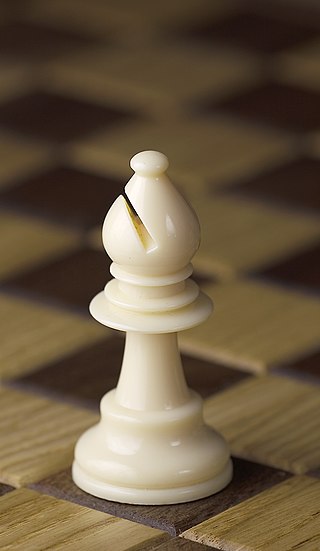Chess strategy is the aspect of chess play concerned with evaluation of chess positions and setting goals and long-term plans for future play. While evaluating a position strategically, a player must take into account such factors as the relative value of the pieces on the board, pawn structure, king safety, position of pieces, and control of key squares and groups of squares. Chess strategy is distinguished from chess tactics, which is the aspect of play concerned with the move-by-move setting up of threats and defenses. Some authors distinguish static strategic imbalances, which tend to persist for many moves, from dynamic imbalances, which are temporary. This distinction affects the immediacy with which a sought-after plan should take effect. Until players reach the skill level of "master", chess tactics tend to ultimately decide the outcomes of games more often than strategy. Many chess coaches thus emphasize the study of tactics as the most efficient way to improve one's results in serious chess play.

The bishop is a piece in the game of chess. It moves and captures along diagonals without jumping over intervening pieces. Each player begins the game with two bishops. The starting squares are c1 and f1 for White's bishops, and c8 and f8 for Black's bishops.

The pawn is the most numerous and weakest piece in the game of chess. It may move one square directly forward, it may move two squares directly forward on its first move, and it may capture one square diagonally forward. Each player begins a game with eight pawns, one on each square of their second rank. The white pawns start on a2 through h2; the black pawns start on a7 through h7.
The opening is the initial stage of a chess game. It usually consists of established theory. The other phases are the middlegame and the endgame. Many opening sequences, known as openings, have standard names such as "Sicilian Defense". The Oxford Companion to Chess lists 1,327 named openings and variants, and there are many others with varying degrees of common usage.
This glossary of chess explains commonly used terms in chess, in alphabetical order. Some of these terms have their own pages, like fork and pin. For a list of unorthodox chess pieces, see Fairy chess piece; for a list of terms specific to chess problems, see Glossary of chess problems; for a list of named opening lines, see List of chess openings; for a list of chess-related games, see List of chess variants; for a list of terms general to board games, see Glossary of board games.
The French Defence is a chess opening characterised by the moves:
The Nimzo-Indian Defence is a chess opening characterised by the moves:
In chess, an X-ray or X-ray attack is a tactic where a piece indirectly controls a square from the other side of an intervening piece. Generally, a piece performing an X-ray either:
Alekhine's Defence is a chess opening that begins with the moves:
The Caro–Kann Defence is a chess opening characterised by Black responding to e4 with c6. Thus:
The Budapest Gambit is a chess opening that begins with the moves:
In chess, a passed pawn is a pawn with no opposing pawns to prevent it from advancing to the eighth rank; i.e. there are no opposing pawns in front of it on either the same file or adjacent files. A passed pawn is sometimes colloquially called a passer. Passed pawns are advantageous because only the opponent's pieces can stop them from promoting.
Handicaps in chess are handicapping variants which enable a weaker player to have a chance of winning against a stronger one. There are a variety of such handicaps, such as material odds, extra moves, extra time on the chess clock, and special conditions. Various permutations of these, such as "pawn and two moves", are also possible.
The Queen's Gambit Accepted (QGA) is a chess opening characterised by the moves:
The Queen's Gambit Declined is a chess opening in which Black declines a pawn offered by White in the Queen's Gambit:
In chess, the exchange is the material difference of a rook for a minor piece. Having a rook for a minor piece is generally advantageous, since the rook is usually more valuable. A player who has a rook for a minor piece is said to be up the exchange, and the other player is down the exchange. A player who wins a rook for a minor piece is said to have won the exchange, while the other player has lost the exchange. The opposing captures often happen on consecutive moves, but this is not strictly necessary. Although it is generally detrimental to lose the exchange, one may occasionally find reason to purposely do so; the result is an exchange sacrifice.
The Queen's Knight Defense is a chess opening defined by the moves:
The Hedgehog is a pawn formation in chess adopted usually by Black that can arise from several openings. Black exchanges the pawn on c5 for White's pawn on d4, and then places pawns on the squares a6, b6, d6, and e6. These pawns form a row of "spines" behind which Black develops their forces. Typically, the bishops are placed on b7 and e7, knights on d7 and f6, queen on c7, and rooks on c8 and e8. Although Black's position is cramped, it has great latent energy, which may be released if Black is able to play ...b5 or ...d5 at some point. These pawn breaks are particularly effective because White usually places pawns on c4 and e4.
In a game of chess, the pawn structure is the configuration of pawns on the chessboard. Because pawns are the least mobile of the chess pieces, the pawn structure is relatively static and thus plays a large role in determining the strategic character of the position.
The Accelerated Dragon is a chess opening variation of the Sicilian Defence that begins with the moves:


